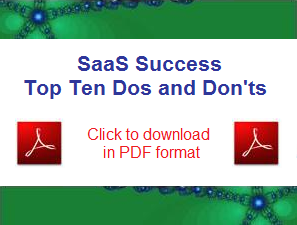
Save it or share it with a colleague.
Click the image above to download the SaaS Top Ten PDF.
For more SaaS business strategy tips,visit or subscribe to Chaotic Flow by Joel York
Or, click below to read the SaaS Top Ten Dos and Don'ts online...
SaaS Do #1 - Choose a Large Market
SaaS Do #2 - Create a Hub on the Web
SaaS Do #3 - Accelerate Organic Growth
SaaS Do #4 - Craft a Compelling Story
SaaS Do #5 - Build the Business into the Product
SaaS Do #6 - Reach across the Firewall
SaaS Do #7 - Monetize Creatively
SaaS Do #8 - Enable Mass Customization
SaaS Do #9 - Open Up to the Cloud
SaaS Do #10 - Leverage Your Community
SaaS Don't #1 - Chase Elephants
SaaS Don't #2 - Waste Money Marketing Offline
SaaS Don't #3 - Launch without Online Trial
SaaS Don't #4 - Cover up Shortcomings with People
SaaS Don't #5 - Invest in Channel Partners too Early
SaaS Don't #6 - Bleed Cash Indefinitely
SaaS Don't #7 - Ignore the Long Tail
SaaS Don't #8 - Think You Can Control It
Software-as-a-Service
Success
The Top Ten Dos and Don’ts of SaaS Business Success
If software-as-a-service is to reach the same level of business success as traditional licensed software SaaS executives and VCs need to adjust their attitudes toward revenue and profitability: growth follows efficiency, not the other way around. Most SaaS companies are not entering wide open markets, and the high volume, high leverage economics make the road to profitability a long one. Everyone gets excited about a stable subscription revenue stream, but they forget that the requirement of long term profitability implies a stable cost structure that is below that revenue line.
If your customer acquisition cost exceeds first year revenue, you should focus on increasing the efficiency of your sales and marketing processes to reduce cost/lead (or increase leads/cost), shorten sales cycles, and reduce or eliminate labor costs. For that matter, why not shoot for an acquisition cost of 50% of first year revenue—if you don’t set the goal, you will never achieve it! No business can sustain negative operating margins, so don’t believe that you can bleed cash indefinitely due to high acquisition and support costs in the hope that a profitable long term cost structure will miraculously emerge as you increase recurring revenue. This is foolish for two reasons: 1) because the subscription price that your customer is willing to pay for your service is completely unrelated to your costs, and 2) because software companies have cultures of innovation, so chances are slim that you will ever run your business as a cash cow in the future to make up for today’s losses. You must consciously make revenue meet costs at a profitable intersection. The sooner you achieve positive operating margins, the greater your chances of long term success—strive for positive cash flow.